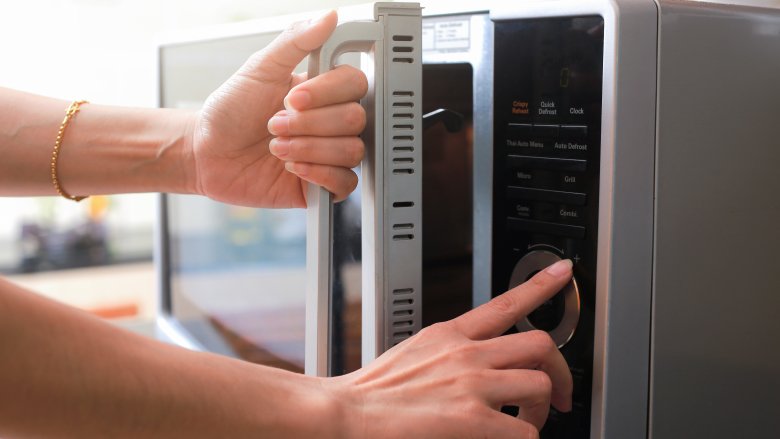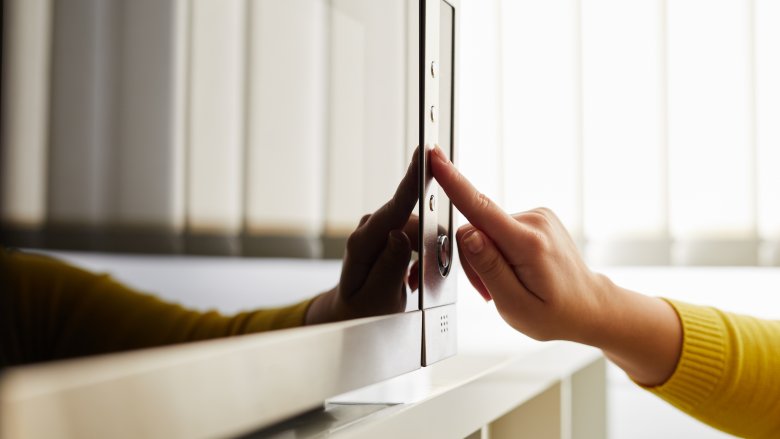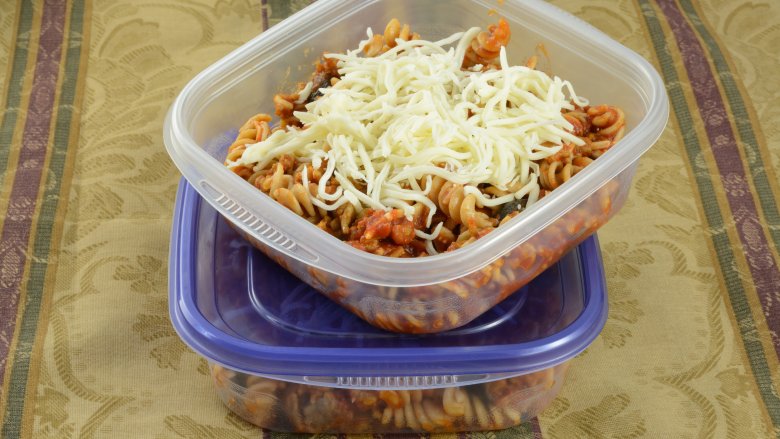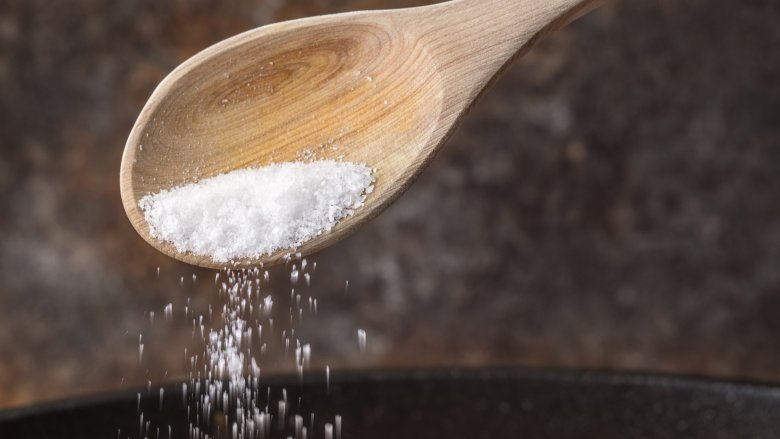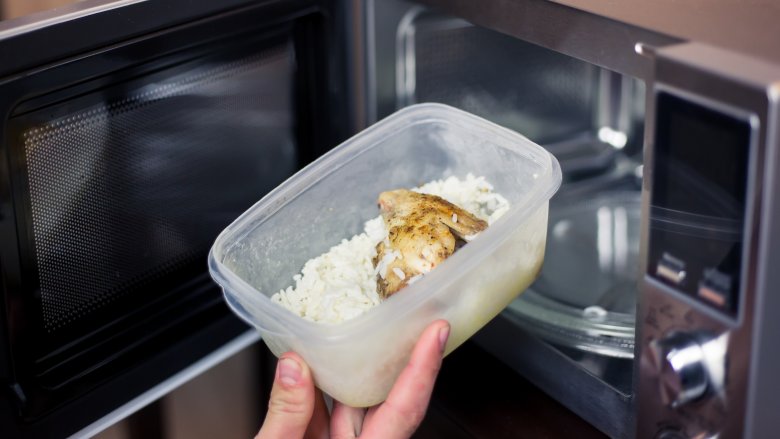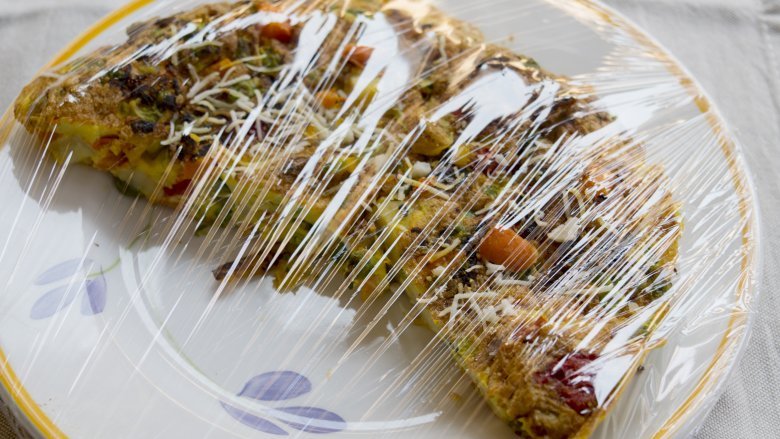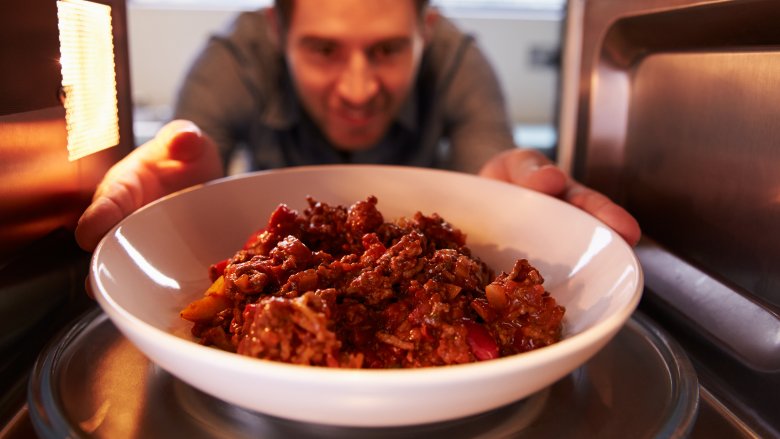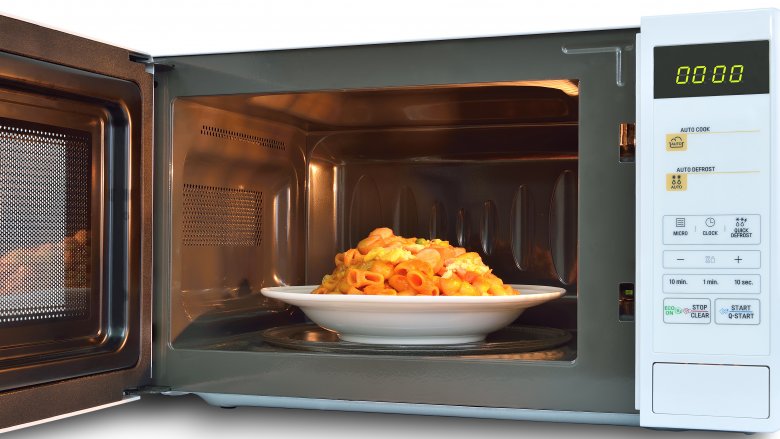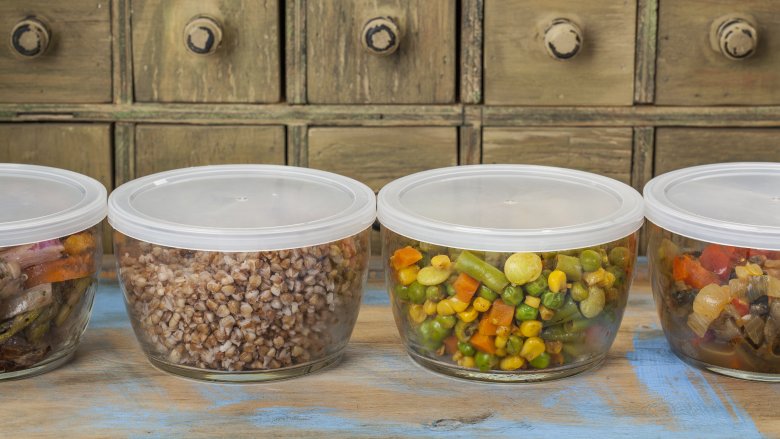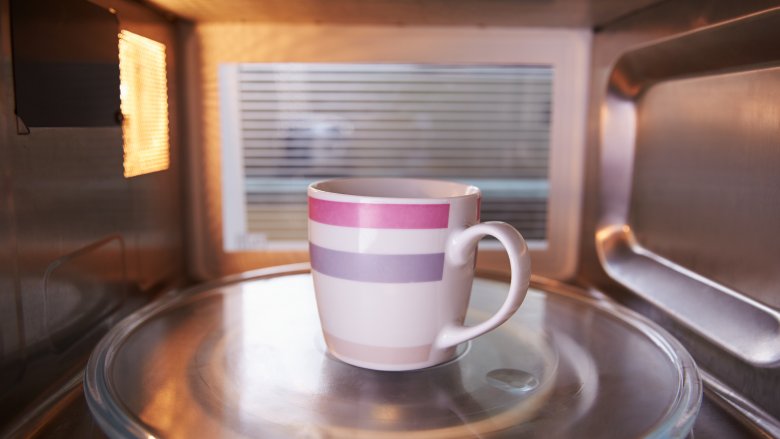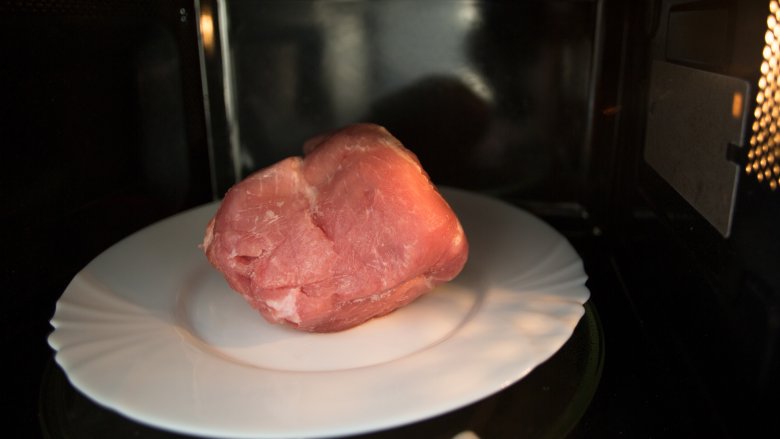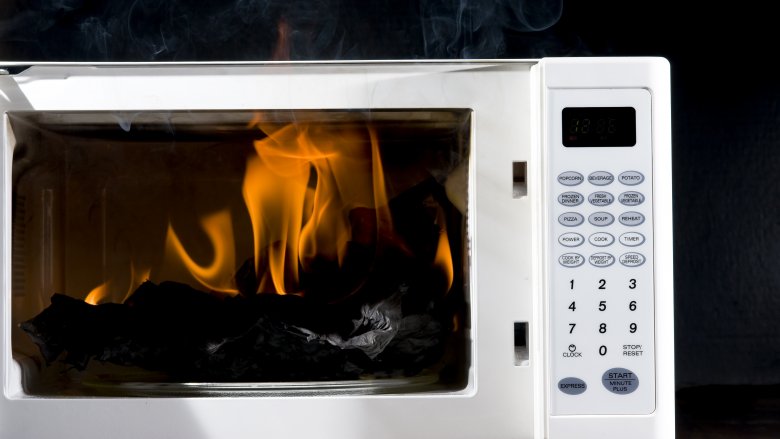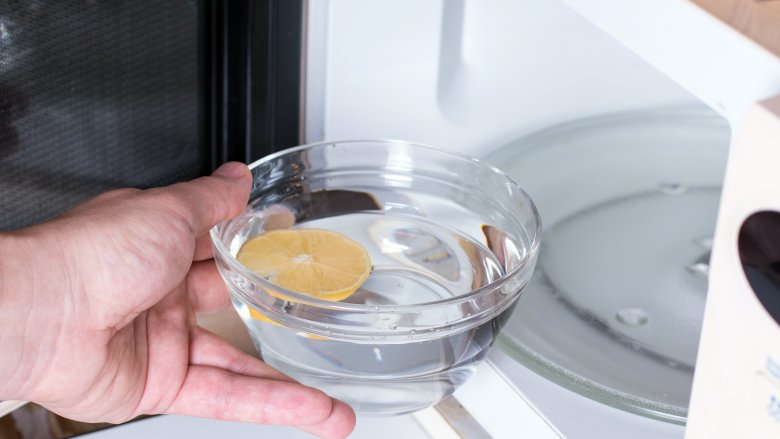You've Been Using Your Microwave All Wrong
Even though we treat the microwave like a one-size-fits-all solution for college students, kids and people who hate to cook, there's more to this common kitchen appliance than simply sticking in a cup of instant ramen and pressing start — that is, if you're using it correctly. And believe it or not, even though you've likely been pushing buttons on this supposedly "simple" appliance for decades, there's still a pretty good chance that you're doing it all wrong.
Mashed has rounded up some of the ways that you might be using your microwave wrong, from kitchen safety disasters that could cause contamination or explosions, to simple changes in procedure that could make your microwaved meals taste a whole lot better.
Keep scrolling to learn more about how to properly use a microwave oven, and you might be surprised at how much you didn't know. After all, the microwave is one of the easiest kitchen appliances to operate, but it's still more complex than it looks.
You only use the highest power setting
This is another case of microwave cooking being more complex than you thought. It's easy to just pop in some refrigerated food, punch in a time, and press go, right? As it turns out, it's just as important to change power settings (or wattage) on your microwave as you would change the temperature of your oven.
Even though every microwave is different, the general rule of thumb is to use the lowest power settings (500 watts and under) for a makeshift dehydrator, like drying out herbs. For 500-800 watts, you can use the microwave to fry or steam foods, and for the highest settings, you can use it to quickly heat up liquids like tea or coffee.
At lower power settings, your food will cook more gently and evenly, so you'll get food that tastes more like it was cooked in a traditional oven, rather than ultra-heated leftovers that have that humid microwave taste.
You're using square containers
This tip is probably surprising even to the most accomplished of microwave chefs. Even though many microwave-safe containers come in a square or rectangle shape, it's best to avoid these and heat your food in a round container (or scoop it onto a microwave-safe plate) to get evenly-cooked food.
When you heat food in containers that are not round, the corners tend to heat up a lot faster than the middle, causing some parts of your meal to be overcooked. According to GE Electronics, the corners of your container will absorb energy from four directions, and the sides of the container will absorb energy from three directions, while the center of the dish will only absorb energy from the top and bottom direction.
When you use a round container, there's a more even surface area so all areas of your Tupperware or plate will heat up at around the same time, according to Plastics Info.
You're salting your food too early
One of the worst microwave mistakes you can make that won't cause you any harm (but will make for poor food quality) is salting your food too early. According to Plastics Info , salt on the surface of food tends to attract the heat created by microwaves. If you sprinkle a lot of salt on your food before microwaving it, the top portion of your food will most likely dry out, as a result.
"Salt molecules tend to break apart in the presence of water," Swamy Anantheswaran, Penn State professor of food science said. "The sodium and chlorine ions create heat by colliding in the rapidly oscillating electromagnetic field, leaving less microwave energy available to heat the center of the food."
Instead, you should season any bland food with salt, pepper, and more after you properly heat up your food. That way it will stay nice and moist, but will still have the desired flavor profile.
You're using just any plastic container
Plastic food storage containers may make microwaving a lot easier, but you can't just pop any plastic bowl in the microwave. Unless your container specifically says that it's microwave safe, don't take a chance. Some plastic containers contain chemicals like phthalates and bisphenol-A (BPAs) — the chemicals that make plastic pliable — which can leach into your food and impact testosterone and estrogen levels, and harm developing fetuses for pregnant women.
You can avoid these health risks by mostly heating food in glass or ceramic containers, and replacing any microwave-safe containers that have been scratched or discolored.
"[If a container is scratched], a certain area designed not to come in contact with food is coming in contact with food and potentially more chemicals present in that container will migrate into food," Rolf Rolf Halden, director of the Center for Environmental Security at the Biodesign Institute at Arizona State University told Time Magazine.
You're covering food with plastic wrap
Of course, no one wants to splatter marinara sauce to all over the microwave while heating up their leftover pasta, but there are smarter ways to cover food than using plastic wrap, like a moist paper towel or microwave-safe storage container top (with the lid popped). Much like the non-microwave-safe plastic containers, plastic wrap contains those nasty phthalates that can leach into your food, thanks to condensation that forms underneath the plastic wrap, Rolf Halden told Time Magazine.
However, the dangers of microwaving plastic wrap are contended by food scientists. Although the USDA states that non-microwave-safe plastic containers like takeout containers or margarine tubs should never be microwaved, the government organization says that plastic film wrap is safe to microwave, as long as the food does not touch the plastic wrap. The USDA also states that plastic storage bags, brown paper bags, plastic grocery bags, and newspapers should never be microwaved for safety reasons.
You're not making the right shape with your food
Have you ever heated up a plate of leftovers for several minutes only to have the edges of the plate turn out boiling hot, while the insides of your dish remained ice-cold? Heating up leftovers in the microwave and ending up with an edible meal might sound like a risk you just have to take, but it has a lot to do with how you plate your cold leftovers before sticking them in the microwave.
According to The Kitchn, to avoid the dreaded icy innards of your leftovers, arrange your food in a ring around the edge of the plate. The more surface area your food takes up on the plate, the more evenly it will heat up. If you can't arrange your leftovers in a circle, simply move the smaller pieces of food to the inside and keep the larger pieces on the outside, since the outside of your plate will heat up faster than the inside.
You're not stirring enough
There's more than one way to end up with unevenly heated leftovers. Besides piling your leftovers high in the center of the plate, the worst thing you could do when microwaving food is to punch a time into the microwave and walk away.
According to The Kitchn, the best way to evenly microwave food is to set the timer for one-minute bursts. In between these one-minute bursts, you should take out your food and stir it, so all of the contents are being evenly-heated. If your food cannot be stirred (like a piece of meat or slice of pizza), simply flip over your food or re-arrange it so all surfaces are being hit evenly. Since microwaves work by moving water molecules around, wherever your dish is wet will likely heat up the fastest. Therefore, unless you stir your food you'll end up with soup that has scalding-hot broth and lukewarm (at best) chicken and vegetables.
You're reheating food that's been left out
Picture this: You're eating a huge holiday meal with your family and the food has been on the table for hours. At the end of the night, you wrap up the leftovers and put them in the fridge for heating up in the microwave the next day. Does this sound familiar?
Unfortunately, leaving out food — even cooked food — for a significant length of time (whether it's hours or mere minutes) can leave you at risk for harmful bacteria that might latch onto your food. Leaving out your food for more than two hours makes it susceptible to a type of bacteria known as Staphylococcus aureus — a common cause of food poisoning. Staph bacteria grows most quickly in a room temperature environment and reheating foods that have been contaminated will not make them safe, according to The Ohio State University.
To prevent this issue, simply refrigerate your leftovers immediately, so that your post-holiday meal isn't contaminated.
You're using it to boil water
We all know a watched pot never boils, but using the microwave would at least speed up the process a bit, right? Actually, you may want to think twice about boiling water in the microwave. Although it's rare, the FDA warns people about "super-heated water" which is when water heats up beyond its boiling point but there are no signs of boiling. This is dangerous because any disturbances or sudden movements might cause the super-heated water to violently explode out of the receptacle, which would cause burns or severe injuries.
You can avoid this potential hazard by adding any ingredient to the water before heating it up in the microwave (like instant coffee, sugar, or tea mix). The extra ingredient will allow the water to heat up normally. Alternatively, you can heat up your coffee or tea without letting it reach a boiling point, and therefore avoiding any super-heated explosions.
You're using it defrost meat
Defrosting raw meat can be a time-consuming endeavor. You might think that speeding things up by sticking your frozen pork loin in the microwave will make the process easier. But frozen meat rarely heats evenly in the microwave, resulting in a chunk of meat that's half-warm and half-frozen. Additionally, according to The Daily Meal, heating up raw meat in the microwave will make the texture of your meat get rubbery, and the uneven heating leaves the meat susceptible to bacterial contamination.
To defrost meat in the safest way possible, you should never defrost in the microwave or at room temperature. Instead, the World Health Organization says you should defrost food in the fridge or in cold water (while using the microwave as a last resort), and that you should cook food immediately after thawing it. Defrosting meat at a colder temperature will slow down any bacterial growth, according to Abertay University professor Costas Stathopoulos.
You're creating a fire hazard without even knowing it
Besides raw frozen meat, there are certain foods that you should never put in the microwave because they are actually a potential fire hazard. Among the most famous microwave no-nos are grapes and raisins. Because of the skin on the grape, the skin joining the flesh of the grape heats up, vaporizes, and turns into a ball of plasma. If you are cooking with raisins, One Good Thing suggests heating up a pot of water and soaking the grapes or raisins for five minutes before letting them drain.
Other foods you should never heat up in the microwave include raw eggs in their shells. Just hard boil your eggs the old-fashioned way (on a stove) to avoid egg explosions and a messy microwave. Much like eggs, heating up hot peppers in the microwave may cause them to explode or catch on fire. When a hot pepper heats up, the capsaicin chemical inside can turn into an airborne weapon similar to pepper spray.
You're not cleaning it enough
Another common mistake people make when using their microwave frequently is only cleaning the microwave if something splatters or when they remember to. But according to The Washington Post, you should be cleaning your microwave at least once a month. NBC's The Today Show says to clean it more often — about once a week — to get rid of any bacteria from leftover food gunk. But simply wiping down the interior of your appliance won't do much to kill of the bacteria.
The best way to clean a microwave is by filling a microwave-safe cup with water and adding several slices of lemon or tablespoons of white vinegar. Then, microwave on high for several minutes (at least three minutes) until the window of the microwave begins to steam. Open the door and wipe down your microwave with a damp cloth or paper towel. Remember to clean the keypad with a microfiber cloth as well.
